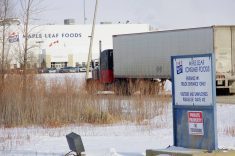Glacier FarmMedia – Canada’s livestock sector will monitor the effects of a new U.S. voluntary country-of-origin labelling ruling announced March 11.
“It is crucial to address any issues that threaten or diminish the cattle and beef trade between Canada and the U.S.,” said Nathan Phinney, president of the Canadian Cattle Association, in a media release.
“We are very concerned that the rule will lead to discrimination against live cattle imports and undermine the beneficial integration of the North American supply chain.”
Read Also

Genesis Fertilizers seeks government funding
Genesis Fertilizers is actively seeking funding from government and a strategic partner. The company dispelled a rumour that DL E&C has abandoned the project.
The USDA’s final “Product of USA” rule comes into effect Jan. 1, 2026, and will restrict companies from adding a “Product of USA” or “Made in the USA” label to meat, poultry and egg products unless the animals they came from were born, raised, slaughtered and processed in the U.S.
The objection from Canadian livestock producer groups, as well as the Canadian government, is that the ruling may stifle access to American markets.
In a joint statment, Canadian agriculture minister Lawrence MacAulay and international trade minister Mary Ng said they were “disappointed that the final rule does not appear to take into account the concerns we have continually brought forward related to our unique and important trading relationship.”
They said they plan to raise the issue when top agricultural officials from the United States and Mexico meet in Colorado later in March.
Mexico’s Ministry of Agriculture and Rural Development issued a release expressing similar disappointment in the ruling.
The USDA said the new ruling simply closes a loophole.
“The rule will prohibit misleading U.S. origin labelling in the market and help ensure that the information that consumers receive about where their food comes from is truthful,” read a news release accompanying the March 11 announcement.
The sides — Canada and Mexico versus the U.S. — stacked up similarly against the now defunct mandatory country-of-origin labelling (mCOOL) law enacted in 2008. It remained in place until 2015 and raised hackles in Canada and Mexico. They argued that it contravened U.S. trade obligations between the three countries.
The law required animals to be segregated if not attached to a U.S. origin label. Canada argued that the red tape and cost of this segregation equated to a trade barrier. A bitter trade battle ensued, culminating in a decision from the World Trade Organization that approved Canada and Mexico to institute billions in retaliatory tarriffs in 2015.
In the wake of the decision, the U.S. spiked COOL.
Six years later, the issue came back to the surface. In February 2021, during U.S. Agriculture Secretary Tom Vilsack’s Senate confirmation hearing, Vilsack said he would look at ways to advance a WTO-compliant version of the regulation.
Armed with a survey that found 65 percent of Americans felt that meat labelled “Product of the U.S.A.” came from animals born, raised and slaughtered in the U.S., Vilsack announced his WTO workaround a year ago. This time, the policy would be voluntary.
Canadian livestock producer groups say mCOOL and vCOOL will have largely the same effect.
CCA executive vice-president Dennis Laycraft said the ruling could have a big impact on the Canadian livestock industry should the same market segregation seen during mCOOL re-emerge.
“That really comes down to how many of the sellers of U.S. beef actually choose to use this label,” he said. “If it becomes a condition of trade down there, it becomes de facto mandatory.”
The Canadian Pork Council is worried about reduced North American livestock trade. In a media release, chair René Roy expressed concern that it could disrupt the market integration of the North American sector.
“These changes, like the original mandatory policy successfully challenged at the World Trade Organization, will have an impact on trade in the integrated Canada/U.S. market,” said Roy. “We are again expressing our disappointment that the final rule did not consider the concerns expressed by Canada and by our American colleagues.”
Laycraft echoed Roy.
“The market integration benefits consumers and the industry in all three countries,” he said. “Those market efficiencies that make food more affordable also make us more competitive internationally.”
Laycraft also said the USDA ruling was unecessarily contentious.
“There were other options available in this rulemaking that were ignored that I think would have respected the benefits of the integrated market,” he said.
One of those options was a label already in existence that said essentially the same thing, according to Laycraft.
“The ‘Born, Raised and Slaughtered in the USA’ label is available for anybody to put on a product if they want; they just have to process-verify it,” said Laycraft. “If there was a strong market demand for it, people would have already been doing it.”
The USDA survey that helped underpin the new regulation did test for consumer demand. It gauged consumer willingness to pay a premium based on various labels.
The study showed that consumers said they were willing to pay 35 percent more for ground beef with a “Product of the USA” label and were willing to pay 24 percent more for ground beef labelled “Born, Raised and Slaughtered in the USA.”
However, for higher-quality cuts, the advantage flipped in favour of the “Born, Raised and Slaughtered in the USA” label. Consumers said they were willing to pay a 37 percent premium for New York strip steak labelled in that way, and a 32 percent premium if it was labelled “Product of the USA.” Results were similar with pork tenderloin.
Laycraft said that kind of labelling doesn’t affect consumers as much as one might think.
“In every survey that I’ve seen, price and quality are the number one and two items affecting (willingness to pay),” he said. “The U.S. and Canadian grading systems mean far more to consumers than this does.”
He is not concerned that American consumers will reject products without the origin label, he said. It’s about whether a critical mass of companies will use this voluntary measure and relegate Canadian livestock to the situation they left nine years ago.
“We’re monitoring whether it will change market behaviour down there,” said Laycraft.
If the Canadian sector can demonstrate the ruling leads to the same segregation as mCOOL , the WTO will likely rule in its favour again, he added.
“The WTO case we won was really about the unfair discrimination against imports; it wasn’t specifically about the mandatory rule.”
















